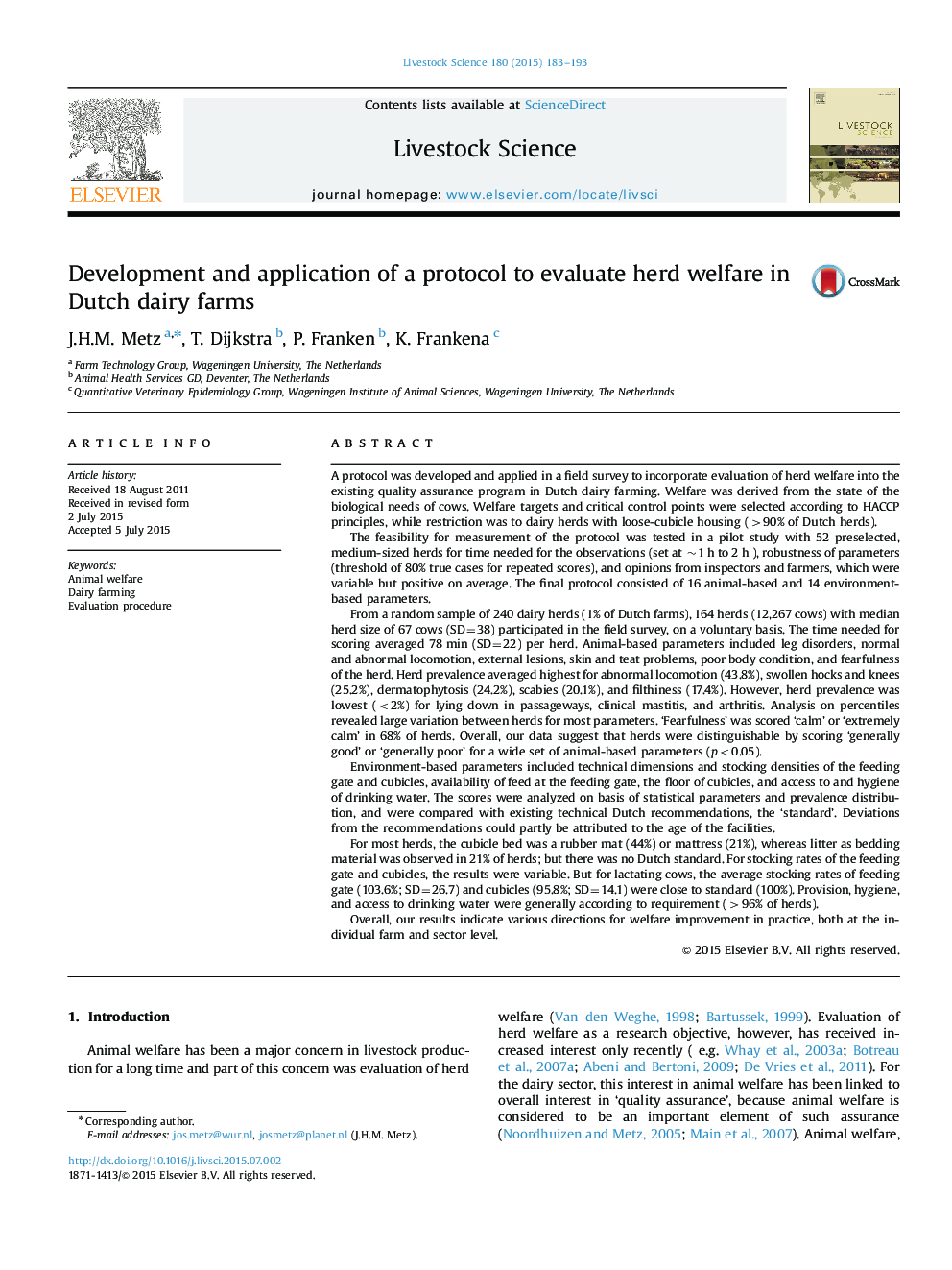| کد مقاله | کد نشریه | سال انتشار | مقاله انگلیسی | نسخه تمام متن |
|---|---|---|---|---|
| 2447039 | 1553952 | 2015 | 11 صفحه PDF | دانلود رایگان |
• A protocol to evaluate critical points in dairy herd welfare was developed.
• The protocol was tested and subsequently applied on 164 herds.
• The protocol included 16 animal-based and 14-environment-based parameters.
• Results indicate various directions for welfare improvement at herd and sector level.
A protocol was developed and applied in a field survey to incorporate evaluation of herd welfare into the existing quality assurance program in Dutch dairy farming. Welfare was derived from the state of the biological needs of cows. Welfare targets and critical control points were selected according to HACCP principles, while restriction was to dairy herds with loose-cubicle housing (>90% of Dutch herds).The feasibility for measurement of the protocol was tested in a pilot study with 52 preselected, medium-sized herds for time needed for the observations (set at ~1 h to 2 h ), robustness of parameters (threshold of 80% true cases for repeated scores), and opinions from inspectors and farmers, which were variable but positive on average. The final protocol consisted of 16 animal-based and 14 environment-based parameters.From a random sample of 240 dairy herds (1% of Dutch farms), 164 herds (12,267 cows) with median herd size of 67 cows (SD=38) participated in the field survey, on a voluntary basis. The time needed for scoring averaged 78 min (SD=22) per herd. Animal-based parameters included leg disorders, normal and abnormal locomotion, external lesions, skin and teat problems, poor body condition, and fearfulness of the herd. Herd prevalence averaged highest for abnormal locomotion (43.8%), swollen hocks and knees (25.2%), dermatophytosis (24.2%), scabies (20.1%), and filthiness (17.4%). However, herd prevalence was lowest (<2%) for lying down in passageways, clinical mastitis, and arthritis. Analysis on percentiles revealed large variation between herds for most parameters. ‘Fearfulness’ was scored ‘calm’ or ‘extremely calm’ in 68% of herds. Overall, our data suggest that herds were distinguishable by scoring ‘generally good’ or ‘generally poor’ for a wide set of animal-based parameters (p<0.05).Environment-based parameters included technical dimensions and stocking densities of the feeding gate and cubicles, availability of feed at the feeding gate, the floor of cubicles, and access to and hygiene of drinking water. The scores were analyzed on basis of statistical parameters and prevalence distribution, and were compared with existing technical Dutch recommendations, the ‘standard’. Deviations from the recommendations could partly be attributed to the age of the facilities.For most herds, the cubicle bed was a rubber mat (44%) or mattress (21%), whereas litter as bedding material was observed in 21% of herds; but there was no Dutch standard. For stocking rates of the feeding gate and cubicles, the results were variable. But for lactating cows, the average stocking rates of feeding gate (103.6%; SD=26.7) and cubicles (95.8%; SD=14.1) were close to standard (100%). Provision, hygiene, and access to drinking water were generally according to requirement (>96% of herds).Overall, our results indicate various directions for welfare improvement in practice, both at the individual farm and sector level.
Journal: Livestock Science - Volume 180, October 2015, Pages 183–193
